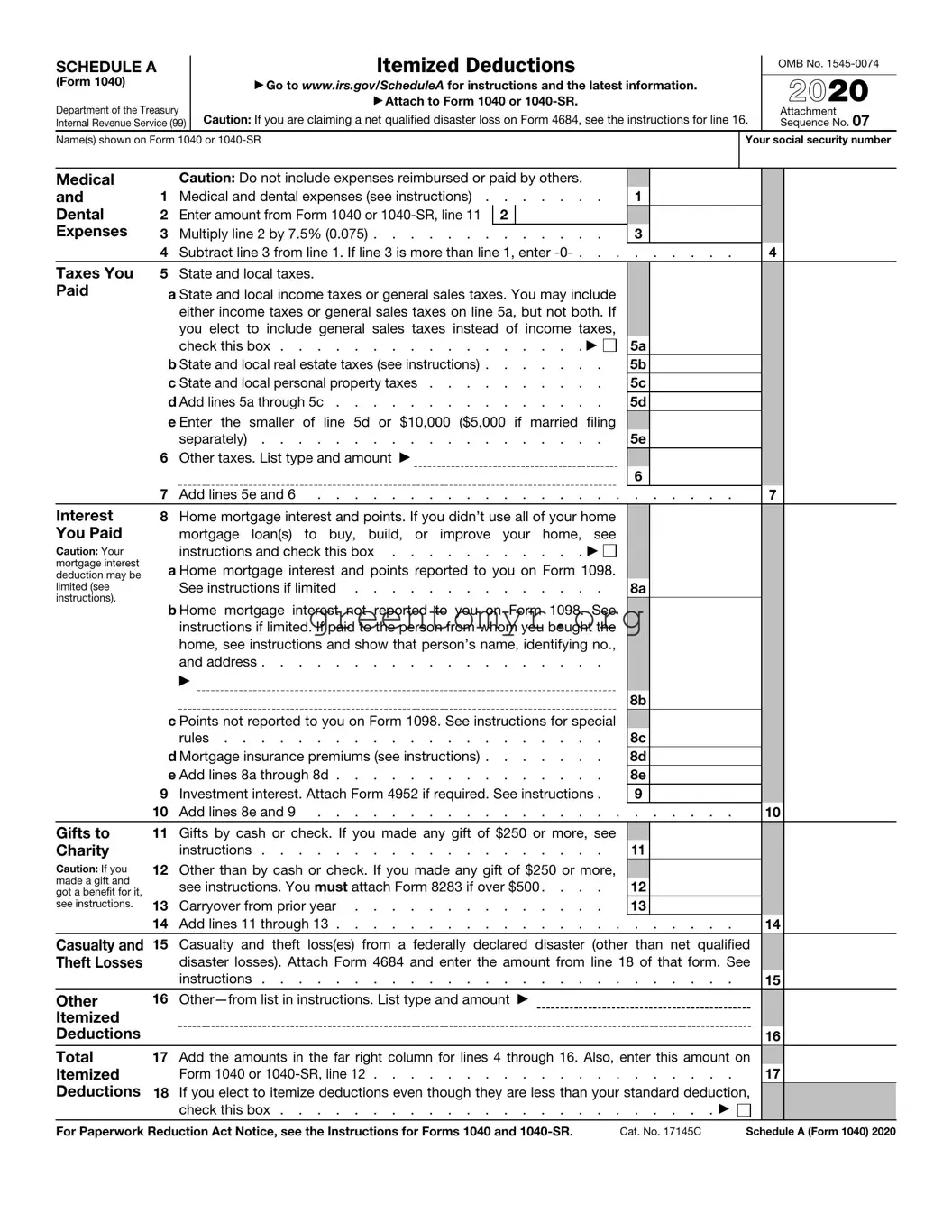Medical |
|
Caution: Do not include expenses reimbursed or paid by others. |
|
|
|
|
|
|
and |
1 |
Medical and dental expenses (see instructions) |
|
1 |
|
|
|
|
Dental |
2 |
Enter amount from Form 1040 or 1040-SR, line 11 |
2 |
|
|
|
|
|
|
|
Expenses |
|
|
|
|
|
|
|
|
|
|
3 |
Multiply line 2 by 7.5% (0.075) |
|
3 |
|
|
|
|
|
4 |
Subtract line 3 from line 1. If line 3 is more than line 1, enter -0- . . . |
. . . . |
. . |
4 |
|
Taxes You |
5 |
State and local taxes. |
|
|
|
|
|
|
|
Paid |
|
a State and local income taxes or general sales taxes. You may include |
|
|
|
|
|
|
|
|
either income taxes or general sales taxes on line 5a, but not both. If |
|
|
|
|
|
|
|
|
you elect to include general sales taxes instead of income taxes, |
|
|
|
|
|
|
|
|
check this box |
. . . . ▶ |
|
5a |
|
|
|
|
|
|
b State and local real estate taxes (see instructions) |
|
5b |
|
|
|
|
|
|
c State and local personal property taxes |
|
5c |
|
|
|
|
|
|
d Add lines 5a through 5c |
|
5d |
|
|
|
|
|
|
e Enter the smaller of line 5d or $10,000 ($5,000 if married filing |
|
|
|
|
|
|
|
|
separately) |
|
5e |
|
|
|
|
|
6 |
Other taxes. List type and amount ▶ |
|
|
|
|
|
|
|
|
|
|
|
|
|
6 |
|
|
|
|
|
7 |
Add lines 5e and 6 |
|
. |
. . . |
. . |
7 |
|
Interest |
8 |
Home mortgage interest and points. If you didn’t use all of your home |
|
|
|
|
|
|
You Paid |
|
mortgage loan(s) to buy, build, or improve your home, see |
|
|
|
|
|
|
Caution: Your |
|
instructions and check this box |
. . . . ▶ |
|
|
|
|
|
|
mortgage interest |
|
a Home mortgage interest and points reported to you on Form 1098. |
|
|
|
|
|
|
deduction may be |
|
|
|
|
|
|
|
limited (see |
|
See instructions if limited |
|
8a |
|
|
|
|
instructions). |
|
b Home mortgage interest not reported to you on Form 1098. See |
|
|
|
|
|
|
|
|
|
|
|
|
|
|
|
|
|
|
|
|
|
|
|
instructions if limited. If paid to the person from whom you bought the |
|
|
|
|
|
|
|
|
home, see instructions and show that person’s name, identifying no., |
|
|
|
|
|
|
|
|
and address |
|
|
|
|
|
|
|
|
▶ |
|
|
|
|
|
|
|
|
|
|
|
|
|
8b |
|
|
|
|
|
|
c Points not reported to you on Form 1098. See instructions for special |
|
|
|
|
|
|
|
|
rules |
|
8c |
|
|
|
|
|
|
d Mortgage insurance premiums (see instructions) |
|
8d |
|
|
|
|
|
|
e Add lines 8a through 8d |
|
8e |
|
|
|
|
|
9 |
Investment interest. Attach Form 4952 if required. See instructions . |
|
9 |
|
|
|
|
|
10 |
Add lines 8e and 9 |
|
. . . . |
. . |
10 |
|
Gifts to |
11 |
Gifts by cash or check. If you made any gift of $250 or more, see |
|
|
|
|
|
|
Charity |
|
instructions |
|
11 |
|
|
|
|
Caution: If you |
12 |
Other than by cash or check. If you made any gift of $250 or more, |
|
|
|
|
|
|
made a gift and |
|
see instructions. You must attach Form 8283 if over $500 . . . . |
|
12 |
|
|
|
|
got a benefit for it, |
|
|
|
|
|
|
see instructions. |
13 |
Carryover from prior year |
|
13 |
|
|
|
|
|
14 |
Add lines 11 through 13 |
|
. . . . |
. . |
14 |
|
Casualty and |
15 |
Casualty and theft loss(es) from a federally declared disaster (other than net qualified |
|
|
Theft Losses |
|
disaster losses). Attach Form 4684 and enter the amount from line 18 of that form. See |
|
|
|
|
instructions |
. . . . |
. . |
15 |
|
Other |
16 |
Other—from list in instructions. List type and amount |
▶ |
|
|
|
|
|
|
Itemized |
|
|
|
|
|
|
|
|
|
|
Deductions |
|
|
|
|
|
|
|
|
16 |
|
Total |
17 |
Add the amounts in the far right column for lines 4 through 16. Also, enter this amount on |
|
|
Itemized |
|
Form 1040 or 1040-SR, line 12 |
. . . . |
. . |
17 |
|
Deductions |
18 If you elect to itemize deductions even though they are less than your standard deduction, |
|
|
|
|
check this box |
. . . . |
. ▶ |
|
|
For Paperwork Reduction Act Notice, see the Instructions for Forms 1040 and 1040-SR. |
Cat. No. 17145C |
Schedule A (Form 1040) 2020 |

